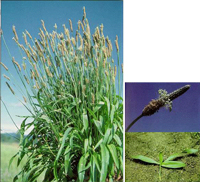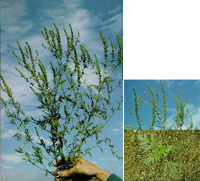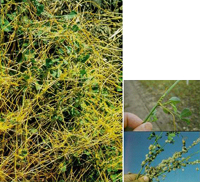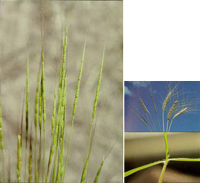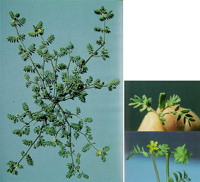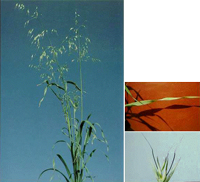Contact Us
Wendy Karol Cecil
Research Associate, Plant Sciences
University of Wyoming
1000 E. University
Agriculture Bldg 4031
Laramie, WY 82071
Phone: (307) 766-2243
Email: wcecil@uwyo.edu
Weeds Study Guides
Wyoming FFA Agronomy Contest
Harmful Weeds
Click on image for full size picture.
Buckhorn Plantain
|
Plantaginaceae (Plantain family) This is a perennial from a stout fibrous rootstock. The crown of the plant is covered with tan woolly hairs. Leaves all basal, 3 to several-veined, narrowly elliptic or lance-elliptic, 4 to 12 inches long, usually less than 1 1/2 inches wide. Flowering stalks are several, up to 18 inches tall, bearing a dense spike of small flowers, subtended by thin ovate bracts; stamens, 4, exerted, conspicuous. Seeds, shiny, 4 per fruit, blackish, about 1/16 inch long. Buckhorn plantain is native to Eurasia and is a weed of roadsides, pastures and other disturbed sites as lawns and gardens. Flowering period is May to August. |
Common Ragweed
|
Asteraceae (Sunflower family) This native annual reaches 4 feet tall. Stems and leaves are blue-green and are covered with fine hairs. Leaves are pinnately divided and are both alternate and opposite. the bottom side of the leaf has a gray appearance because of fine hairs. Flowers are found on terminal branches, which have male and female flowers in clusters with staminate flowers found above the pistillate flowers. Seeds are awl-shaped with a spiny projection on one side. Flowereiong occurs in late summer, with seeds maturing by October. This annual is common throughout the western U.S. causing many individuals to have hay fever. Even though it is commonly found along ditches and in waste areas. |
Field Dodder
|
Convolvulaceae (Morning-glory family) This parasitic annual lacks chlorophyll. Stems are yellowish, thread-like and twining, leaves are reduced to thread-like scales. Flowers are numerous in compact clusters, 5-parted and shallowly cupped, white to pink. fruit is a 2- to 4-seeded globular capsule which is somewhat depressed on the top. Seeds are small, oval, gray to red and 1/25 inch in length. Dodder is widely distributed over much of the U.S. with several species present in the western United States. Dodder seed germinate on the soil surface and the resulting plant develops a small root system and 2- to 4-inch long thread-like stalk which attaches to green plants. Once attached, the root system disappears and the dodder becomes wholly parasitic. Many broadleaf plants serve as hosts for this parasite, but alfalfa and clover are especially susceptible. Dodder seeds are fairly long-lived in the soil and infestation may occur in areas where host plants were not grown for several years. Flowering period is July to October. |
Jointed Goatgrass
|
Poaceae (Grass family) Jointed goatgrass is a winter annual, 15 to 30 inches tall with one to many erect stems or tillers. Leaves are alternate, simple, with auricles at the base and a leaf blade 1/8 to 1/4 inch wide, with hairs. The spike is cylindrical, mor than 10 times as long as it is wide. It contains 2 to 12 spikelets that fit into the contour of the rachis, spikelets 1/2 inch long with 1 to 3 viable seeds. Glumes several-ribbed with a keel on one side extending into a single awn or beard. At maturity spikelets separate with a segment of the rachis still attached. Jointed goatgrass is native to southern Europe, but it is now established in most winter wheat growing areas of North America, spread as a seed contaminant or by custom combiners. It is found mostly in wheat fields, but it survives along roadsides, in waste areas, alfalfa fields and pastures. The plant is most difficult to control in areas where winter wheat is grown continuously. Flowering and seed production may occur from May to July. |
Puncturevine
|
Zygophyllaceae (Caltrop family) Puncturevine is annual, prostrate or somewhat ascending, mat forming, with trailing stems, each 1/2 to 5 feet long. Leaves opposite, hairy, divided into 4 to 8 pairs of leaflets, each about 1/4 to 1/2 inch long and oval. Flowers are yellow, 1/3 to 1/2 inch wide with 5 petals, borne in the leaf axils. Fruits consist of 5 sections which, at maturity, break into tack like structures with sharp, sometimes curving spines, each section 2- to 4-seeded. Puncturevine was introduced from southern Europe and is now widely scattered over much of the U.S. It grows in pastures, cultivated fields, waste areas, and along highways and roads. The hard, spiny burs damage wool, are undesirable in hay, and may cause injuries to livestock. Bicycle tires are frequently punctured by the burs. the seed will remain dormant in the soil for 4 to 5 years, which makes eradication difficult. Because of its sharp burs, puncturevine has been spread over a wide area by animals and vehicles. Flowering and seed production occur from July to October. |
Wild Oats
|
Poaceae (Grass family) Wild oat is an annual, 1 to 4 feet tall with erect hallow stems. Leaf blades are 1/8 to 5/8 inch wide, sheaths open, ligules membranous. The seedling leaves twist counterclockwise. The inflorescence is an open panicle, 4 to 18 inches long, drooping, spikelets contain 2 to 3 florets which disarticulate above the glumes. Seeds are yellow to black, narrowly oval, 1/4 to 1/2 inch long. This species is distinguished form domestic oats by the twisted awn which bends at right angles and a horseshoe-shaped scar at its seed base. Wild oat is a native to Europe, but is common throughout much of western North America. It is a serious problem in spring-seeded small grain, but it also occurs along roadsides, in pastures and waste areas. Seed can remain dormant in the soil for as long as 10 years, making it difficult to eliminate once established. Flowering and seed production occur from June to August. |
Contact Us
Wendy Karol Cecil
Research Associate, Plant Sciences
University of Wyoming
1000 E. University
Agriculture Bldg 4031
Laramie, WY 82071
Phone: (307) 766-2243
Email: wcecil@uwyo.edu

